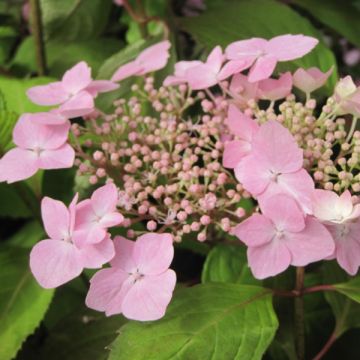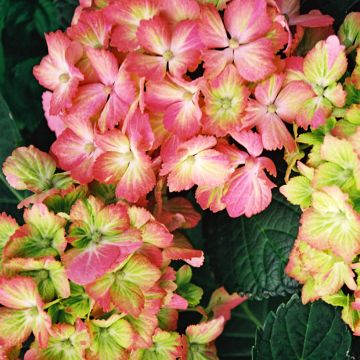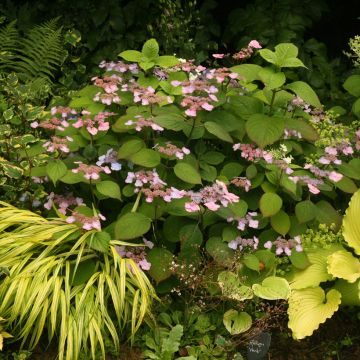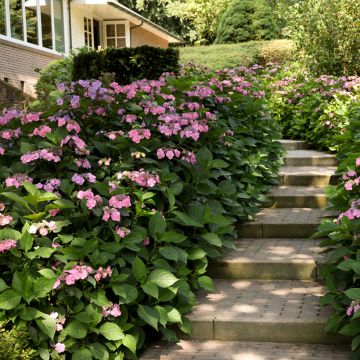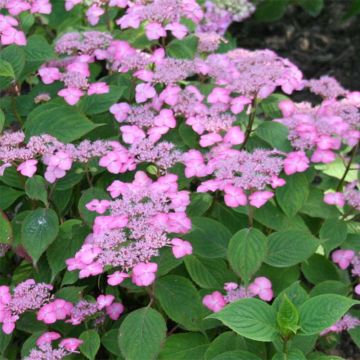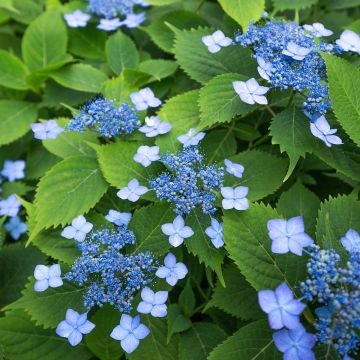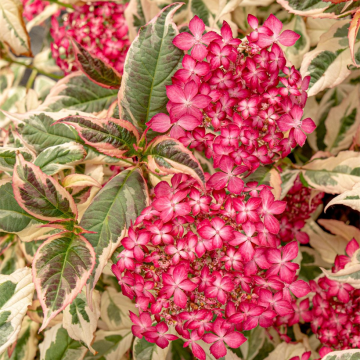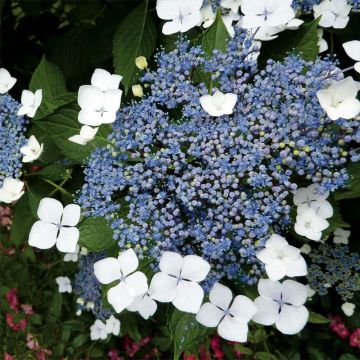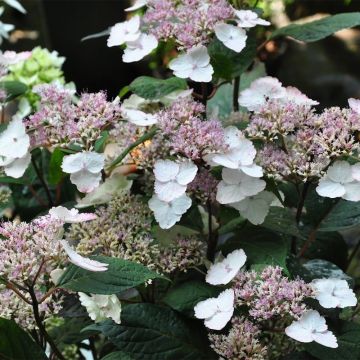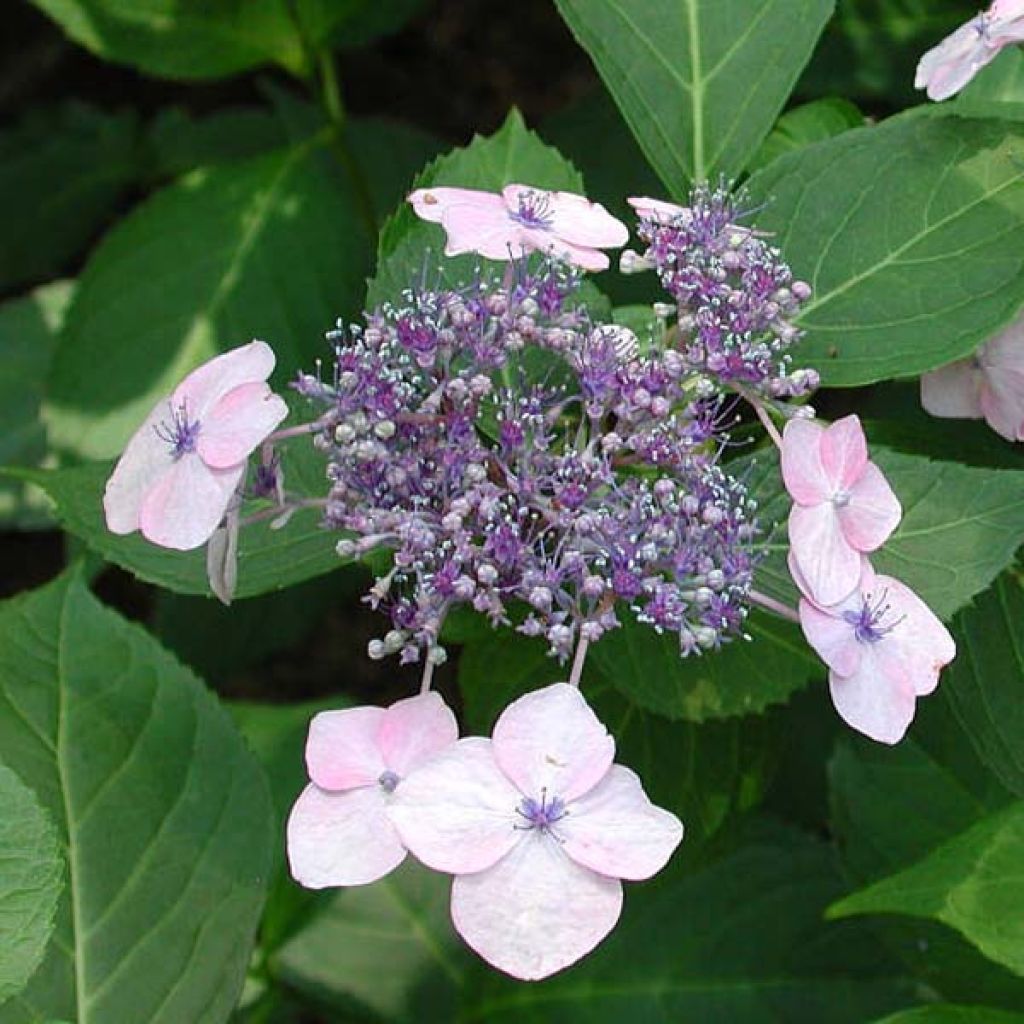

Hydrangea serrata Tiara - Mountain Hydrangea
Hydrangea serrata Tiara - Mountain Hydrangea
Hydrangea serrata Tiara
Mountain Hydrangea, Tea of Heaven
This item cannot be shipped to the selected country
Delivery charge from €5.90
More information
Schedule delivery date,
and select date in basket
This plant carries a 24 months recovery warranty
More information
We guarantee the quality of our plants for a full growing cycle, and will replace at our expense any plant that fails to recover under normal climatic and planting conditions.
From €5.90 for pickup delivery and €6.90 for home delivery
Express home delivery from €8.90.

Does this plant fit my garden?
Set up your Plantfit profile →
Description
Hydrangea serrata 'Tiara' is a Japanese hydrangea that will surprise you with its floribundity. From mid-June to September, its flat inflorescences, light as lace, adorned with sterile florets with pointed lavender blue sepals surround the fertile florets, pink to red. The foliage is not to be outdone, taking on a beautiful flaming purple-red colour at the end of summer. Very hardy, it adapts well to harsh climates. Its compact growth habit is well suited for cultivation in large containers, but it will also thrive in partially shaded flower beds.
Originating from Japan and Korea, Hydrangea serrata are very hardy plants belonging to the Hydrangeaceae family. They present themselves as highly branched, bushy, and rounded shrubs, with the 'Tiara' hydrangea reaching a height of about 1.20m (4ft) with an equivalent spread. It is distinguished by its dark green leaves, which are smaller and more ovate than those of Hydrangea macrophylla, and take on a beautiful purple-red hue from the end of summer. Extremely floriferous, its flat and airy panicles bloom from mid-June, with its sterile flowers, pointed in shape and ranging in colour from light blue to pink depending on the soil acidity, surrounding fertile flowers in bud form, in shades of pink to red. This very hardy variety can withstand temperatures as low as -25°C (-13 °F) and can even be used in more continental climates. Hydrangeas are robust plants that can live for at least 50 years.
Hydrangea serrata 'Tiara' particularly appreciates moist soils and partial shade. It will elegantly showcase its rounded silhouette and pastel flowering. Hydrangeas are well known for brightening up the north side of houses, and this variety will thrive in partially shaded areas, in flower beds, and as hedges. This variety is particularly well-suited for container cultivation, which can be placed on the terrace or near the entrance. Although these plants dislike calcareous soils, they are not strictly acid-loving plants. Pair them with Magellan fuchsias, annual impatiens, or plant spring-flowering bulbs in front of their rounded form. Enjoy their magnificent flowering in the garden or indoors for a long time.
Report an error about the product description
Hydrangea serrata Tiara - Mountain Hydrangea in pictures
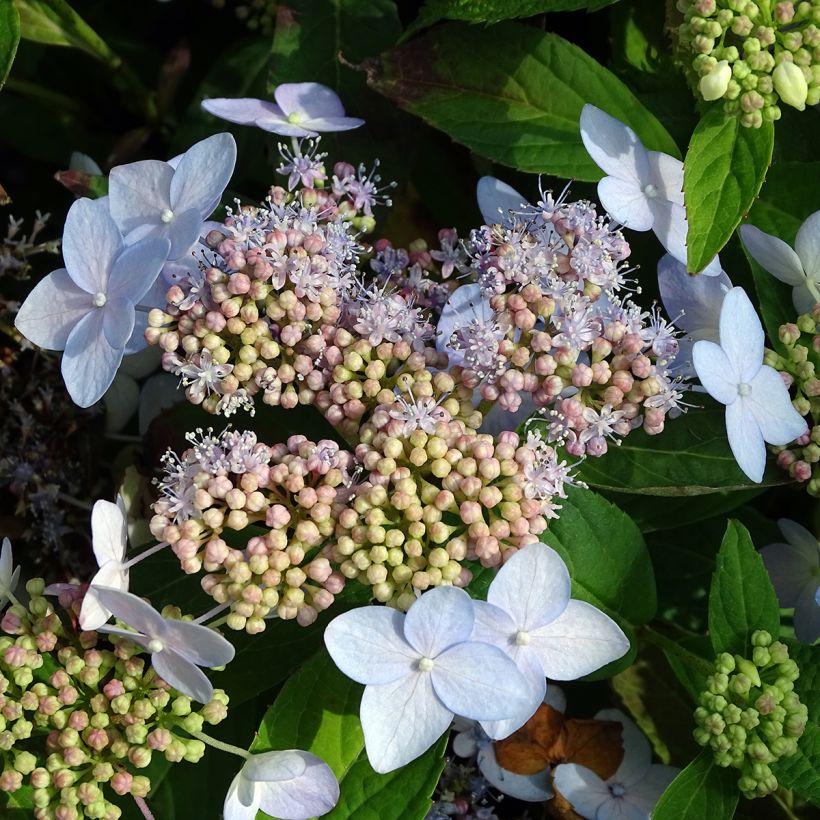

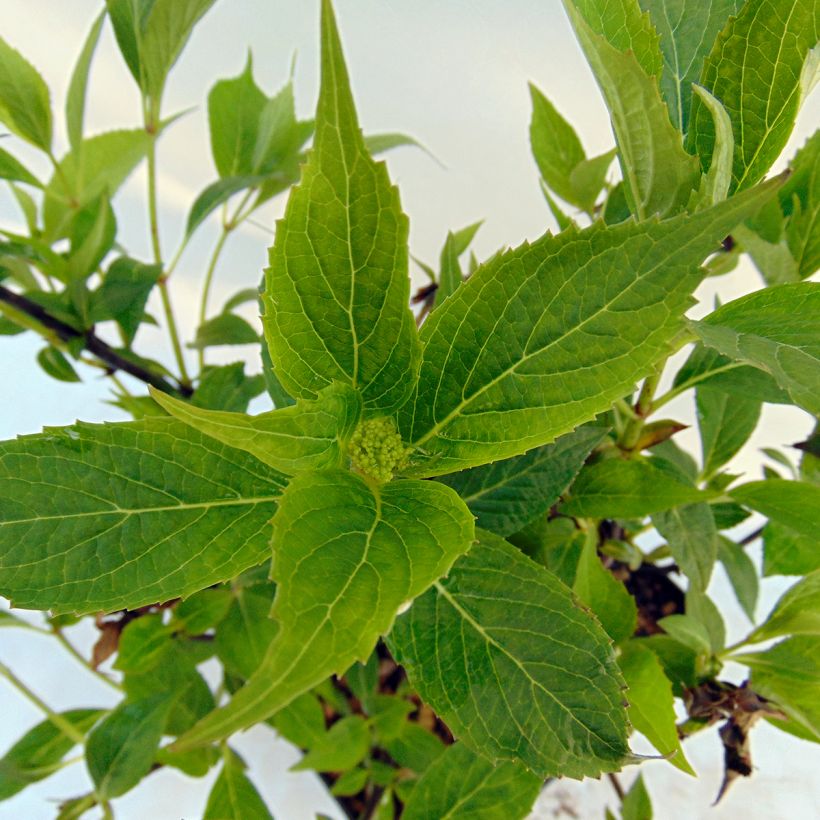

Plant habit
Flowering
Foliage
Botanical data
Hydrangea
serrata
Tiara
Hydrangeaceae
Mountain Hydrangea, Tea of Heaven
Cultivar or hybrid
Other Hydrangea serrata
Planting and care
Hydrangea serrata 'Tiara' will appreciate a spot where it receives morning or late afternoon sun, protected from midday sun. You can place it at the base of a wall or in the light shade of a taller tree. Planting: This Hydrangea requires a sunny or partially shaded location depending on the moisture of your soil and a neutral to acidic soil. At planting, place it in deeply worked soil. A good base fertilizer (horn or dehydrated blood) will promote the establishment of your plant and nourish it without risk of burning. If your soil tends to be dry, mix our water retainer, stockosorb, with the soil when backfilling the planting hole and provide a watering basin on the surface. At the end of summer, we advise you not to cut the dry umbels which will protect the terminal shoots of the branches in winter. Cut all the dry flowers at the end of February or at the first signs of spring.
Planting period
Intended location
Care
-
, onOrder confirmed
Reply from on Promesse de fleurs
Haven't found what you were looking for?
Hardiness is the lowest winter temperature a plant can endure without suffering serious damage or even dying. However, hardiness is affected by location (a sheltered area, such as a patio), protection (winter cover) and soil type (hardiness is improved by well-drained soil).

Photo Sharing Terms & Conditions
In order to encourage gardeners to interact and share their experiences, Promesse de fleurs offers various media enabling content to be uploaded onto its Site - in particular via the ‘Photo sharing’ module.
The User agrees to refrain from:
- Posting any content that is illegal, prejudicial, insulting, racist, inciteful to hatred, revisionist, contrary to public decency, that infringes on privacy or on the privacy rights of third parties, in particular the publicity rights of persons and goods, intellectual property rights, or the right to privacy.
- Submitting content on behalf of a third party;
- Impersonate the identity of a third party and/or publish any personal information about a third party;
In general, the User undertakes to refrain from any unethical behaviour.
All Content (in particular text, comments, files, images, photos, videos, creative works, etc.), which may be subject to property or intellectual property rights, image or other private rights, shall remain the property of the User, subject to the limited rights granted by the terms of the licence granted by Promesse de fleurs as stated below. Users are at liberty to publish or not to publish such Content on the Site, notably via the ‘Photo Sharing’ facility, and accept that this Content shall be made public and freely accessible, notably on the Internet.
Users further acknowledge, undertake to have ,and guarantee that they hold all necessary rights and permissions to publish such material on the Site, in particular with regard to the legislation in force pertaining to any privacy, property, intellectual property, image, or contractual rights, or rights of any other nature. By publishing such Content on the Site, Users acknowledge accepting full liability as publishers of the Content within the meaning of the law, and grant Promesse de fleurs, free of charge, an inclusive, worldwide licence for the said Content for the entire duration of its publication, including all reproduction, representation, up/downloading, displaying, performing, transmission, and storage rights.
Users also grant permission for their name to be linked to the Content and accept that this link may not always be made available.
By engaging in posting material, Users consent to their Content becoming automatically accessible on the Internet, in particular on other sites and/or blogs and/or web pages of the Promesse de fleurs site, including in particular social pages and the Promesse de fleurs catalogue.
Users may secure the removal of entrusted content free of charge by issuing a simple request via our contact form.
The flowering period indicated on our website applies to countries and regions located in USDA zone 8 (France, the United Kingdom, Ireland, the Netherlands, etc.)
It will vary according to where you live:
- In zones 9 to 10 (Italy, Spain, Greece, etc.), flowering will occur about 2 to 4 weeks earlier.
- In zones 6 to 7 (Germany, Poland, Slovenia, and lower mountainous regions), flowering will be delayed by 2 to 3 weeks.
- In zone 5 (Central Europe, Scandinavia), blooming will be delayed by 3 to 5 weeks.
In temperate climates, pruning of spring-flowering shrubs (forsythia, spireas, etc.) should be done just after flowering.
Pruning of summer-flowering shrubs (Indian Lilac, Perovskia, etc.) can be done in winter or spring.
In cold regions as well as with frost-sensitive plants, avoid pruning too early when severe frosts may still occur.
The planting period indicated on our website applies to countries and regions located in USDA zone 8 (France, United Kingdom, Ireland, Netherlands).
It will vary according to where you live:
- In Mediterranean zones (Marseille, Madrid, Milan, etc.), autumn and winter are the best planting periods.
- In continental zones (Strasbourg, Munich, Vienna, etc.), delay planting by 2 to 3 weeks in spring and bring it forward by 2 to 4 weeks in autumn.
- In mountainous regions (the Alps, Pyrenees, Carpathians, etc.), it is best to plant in late spring (May-June) or late summer (August-September).
The harvesting period indicated on our website applies to countries and regions in USDA zone 8 (France, England, Ireland, the Netherlands).
In colder areas (Scandinavia, Poland, Austria...) fruit and vegetable harvests are likely to be delayed by 3-4 weeks.
In warmer areas (Italy, Spain, Greece, etc.), harvesting will probably take place earlier, depending on weather conditions.
The sowing periods indicated on our website apply to countries and regions within USDA Zone 8 (France, UK, Ireland, Netherlands).
In colder areas (Scandinavia, Poland, Austria...), delay any outdoor sowing by 3-4 weeks, or sow under glass.
In warmer climes (Italy, Spain, Greece, etc.), bring outdoor sowing forward by a few weeks.

































